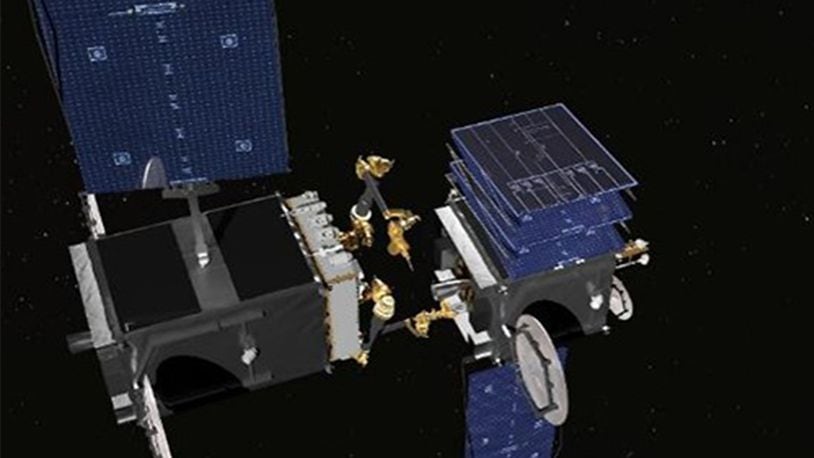Commercial industry and government agencies believe they’re getting close to ab answer: robot repairs.
The idea is to extend the lives of satellites with in- orbit satellite servicing, with robotic spacecraft traveling from satellite to satellite to refuel them and fix problems.
Industry watchers see the heightened activity as commercial validation for a 30-year-old idea that, until recently, attracted only government dollars.
“I think it could be a sustainable market,” said Carissa Christensen, chief executive of space analytic consulting firm Bryce Space and Technology.
One of the first such commercial robot technicians is expected to launch next year, but analysts say a mature market is still at least 10 years away. Not only do the spacecraft and capabilities still need to be fine-tuned, but the space industry, which is relatively conservative, will also want to see several demonstrations before signing on.
“It’s an environment where you can’t make mistakes,” said Steve Oldham, senior vice president of strategic business development at SSL, a division of San Francisco-based Maxar Technologies that has such a project.
Technology still needs to advance to the point where robots become capable service workers. Already, though, the number of satellites that will need servicing is rising rapidly.
In 2016, there were more than 1,400 operational satellites in orbit, compared to 994 in 2012, according to a June report commissioned by the Satellite Industry Association trade group and written by Bryce Space and Technology. Many are programmable, meaning their software can be updated throughout their lifespans, which can stretch to 10 or 15 years.
NASA has started to develop some of the necessary technology. In February, the space agency launched a sensor called Raven during a cargo resupply mission for the International Space Station.
Raven can track vehicles approaching the space station before stretching out an arm to grab it.
“Satellites in low-Earth orbit are traveling anywhere between 15,000 and 18,000 mph,” said Ben Reed, deputy division director of NASA Goddard Space Flight Center’s satellite servicing projects division, which developed Raven. “We need to put our servicer underneath it with a robotic catcher’s mitt in the right place.”
NASA’s satellite servicing projects division was born out of previous missions to maintain and service another expensive asset — the Hubble Space Telescope. Astronauts aboard space shuttles serviced the telescope five times, with the last mission in 2009 focused on replacing circuit boards and adding sensors. When the shuttle program ended, NASA’s ability to access and service space assets disappeared, Reed said.
The division is also developing refueling technologies and is working to launch a fully robotic spacecraft that will go to an existing satellite in orbit, autonomously capture and then refuel it.
The autonomous-capture aspect is important, Reed said, because waiting for a video signal to reach human operators on Earth would just be too slow. The round-trip delay between moving that spacecraft’s robotic arm and seeing the result on video can take about three seconds.
“We need rapid, rapid, rapid,” he said, snapping his fingers. “You don’t think when you reach out your hand to catch a set of car keys.”
Less time-sensitive tasks, such as cutting wires, will be done robotically via human operators on the ground.
NASA’s satellite servicing project division is not intended to compete with industry, but rather transfer the technology it develops to interested parties, Reed said.
Rocket and satellite maker Orbital ATK Inc., which was recently acquired by defense giant Northrop Grumman Corp., has begun assembling a service spacecraft known as the Mission Extension Vehicle-1. The craft is set for launch next year with service starting as soon as 2019.
Orbital ATK has signed satellite operator Intelsat as its first customer. The spacecraft’s structures, solar arrays and propellant tanks are being manufactured in San Diego and Goleta, Calif.
In June, satellite and spacecraft manufacturer SSL announced a new business venture focused specifically on in-orbit satellite servicing. SSL was selected in February by the Defense Advanced Research Projects Agency to be its commercial partner in a program to service satellites in geosynchronous orbit. SSL will build the spacecraft and the refueling capability while DARPA provides robotic tools and software.
The spacecraft will be test-launched in 2021. SSL is developing it at a satellite manufacturing facility in Palo Alto; two robotic arms are being built at a subdivision in Pasadena. SSL has already signed its first commercial customer, Luxembourg-based satellite operator SES.
Some analysts question whether this robot repair squad will be needed at all. A coming boom in small, cheap satellites could replace some more expensive, large satellites. With reduced launch costs, led by Elon Musk’s SpaceX and its reusable rockets, it could be cheaper to launch several new small satellites than fix or refuel old ones.
But Christensen of Bryce Space and Technology is confident there will be a need for a high-and-low mix of satellites. And she points out that cheaper launch costs could drive more repairs.
“If you’ve got a quarter of a billion dollars of hardware on orbit, it seems like it would be useful to figure out an application for that,” Christensen said.
About the Author
